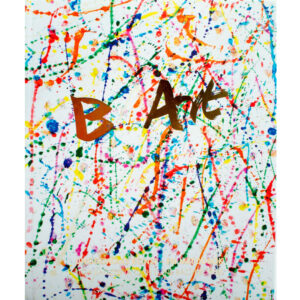
In the book ”B Art – Ungdomars konst – En Metodbok”, project leaders Lone Bach Borius and Liga Lagzdina describe how they launched B-Art in the spring of 2015 – an art project for young people aged 13 to 18.
Here, they share their experiences and practical tips. What forms of expression should you choose to work with? What does the work process look like up to the finished exhibition? What should you consider when collaborating with artists, and what is the role of the project leader? These are some of the questions the book addresses, along with a wealth of images from the three years and interviews with young people, artists, and partners who participated in the project.
Chapters in the Book:
Bakgrund
Vikten av kreativitet
Projektledarna
Konstnärssamarbeten
Demokrati
Öppen verksamhet
Rummets betydelse
Marknadsföring
Samarbetspartners
Startkit för ditt eget B Art
Drömmar om framtiden
Sample from the Chapter “Vikten av kreativitet”
Sample from the Chapter “Demokrati”
Order the book
See Your Art works to identify success factors for working with children’s art and making their creations visible in exhibitions. It is an ongoing and exciting endeavor that we undertake together with all project participants. We will continually share our findings here.
Background
The inspiration to define success factors comes from the library world. There, developed quality criteria exist for how a school library can improve and evolve. Professor Louise Limberg has developed four steps (or levels) for how a library functions.
Level one is “The Library as a Storage Facility,” and step four is “A Library with Development Work.” Additionally, the National School Library Group annually awards the prestigious prize “School Library of the Year,” evaluating aspects such as development work, value work, integration, staffing, and more.
Naturally, the criteria for libraries are not directly transferable to work with children’s art. However, we believe that something similar would be very useful and inspiring. Currently, no such criteria exist. Instead of the term “criteria,” we have chosen “success factors.”
What is the purpose of success factors for working with children’s art?
-To create a tool with guidelines that facilitate and strengthen the work with art both during and after the See Your Art project.
How should we formulate the success factors?
-The success factors for working with children’s art should be concrete and evaluable, both quantitatively and qualitatively.
How should the success factors be used?
-The participants in the See Your Art project will apply and evaluate the success factors.
How do we give children influence and participation in developing the success factors?
-Children’s voices, reflections, and suggestions will be heard by actively involving them through the adult project participants. This will occur through evaluations, exhibition curation, communication efforts, and documentation.
In 2022, See Your Art conducted an exercise with the adult participants based on a hypothetical situation. The aim was to find concrete questions that could reveal how well the conditions for successful work with children’s art are in a municipality. Participants in the workshop included art educators, museum educators, and cultural secretaries.
The background is that those of us who work in the cultural sector are often used to answering questions. We write reports, applications, and evaluations. We thought it would be interesting to have the adult participants write questions to identify municipalities that were already on the right track and therefore deserved a financial boost in the form of a “barn-krea-miljard”.
Participants were given a storyline to work from. It goes like this:
A cultural director has worked successfully with children’s art, creativity, and democracy. They are asked by the Minister of Culture to write questions for other municipalities. The purpose is to reveal whether the municipalities are working as successfully as the cultural director. The Minister of Culture wants to distribute 1 billion to 10 municipalities that are well on their way to working successfully with children’s art.
Here is the compilation from the participants:
Regarding Steering Documents
Does the municipality have a cultural guarantee for ages 1-20 years?
Does the municipality have a cultural plan with evaluable goals?
Regarding Children’s Perspective
What competence does the municipality have regarding children’s perspective?
How does the municipality reach all children of all ages and cultures, even outside of school?
Regarding Economy
Who has influence over how the municipality’s cultural funds are distributed?
Who will benefit from the additional granted cultural funds?
Regarding Cooperation
How do various actors within and outside the municipality collaborate on children’s culture?
Regarding Successful Cultural Projects
Give examples of successful cultural projects (that you are proud of)
Regarding Long-term Vision
How will it be evident in the long term that the municipality has received external cultural funds?
Regarding Dreams
If your municipality receives a billion and can dream freely, what would you like to do?
Why is your municipality applying for the funds?
Fyll i dina uppgifter och ditt meddelande. Skicka sedan ditt mejl med den blåa knappen.